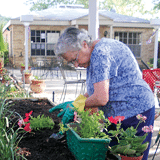When your average income is between $9,000 to $18,000 per year, sustainability is vitally important. That’s the premise of the San Antonio Housing Authority (SAHA), whose 27,000 households fall into the low end of the economic spectrum. And yet sustainability comes in different forms, including vegetables.
SAHA currently has eight community gardens at various senior properties, and their importance can’t be overlooked. These gardens give residents the opportunity to interact and to put healthful food on their tables. “We have a public housing property with a community garden next to our central office,” says Lourdes Castro Ramírez, president and CEO of SAHA, “and when I leave at night, I see residents out there looking at their vegetables and talking to other people.” Veronica Guevara, director of construction services and sustainability, adds, “The gardens get people excited and moving. Gardening isn’t just about growing a zucchini—it brings real purpose to our residents’ lives.”

SAHA made space for community gardens in several of its elderly and disabled communities to improve residents’ quality of life by increasing physical activity, reducing chronic disease, and improving nutrition.
This sense of community is most obvious at SAHA’s poster community, the Lewis Chatham Apartments, which were built in 1973 and rehabilitated in October 2011 using $7 million of funding received through the American Recovery and Reinvestment Act. The four-story, 119-unit building has all of the green bells and whistles. It was built with eco-friendly materials, and it has a tight envelope, an energy-efficient HVAC system, and Energy Star appliances. It features a low-water garden, designed by University of Texas at San Antonio architecture students, with native plants and the community garden. It is the first multifamily retrofit in San Antonio to be certified Build San Antonio Green Level 2, a local green-building standard. “Inside and out, the Lewis Chatham Apartments are a model of how we want to do things moving forward,” Guevara says.
The Lewis Chatham Apartments also show the willingness of the SAHA community to accept change. It was the first SAHA complex to implement a building-wide non-smoking policy when it opened in October 2011. A few months later, SAHA extended that policy to all of its 6,322 public housing units. “Sustainability really resonates with the families we serve, and residents have been very involved,” Castro Ramírez says. “It’s important that residents be partners with us in these initiatives, and we spent a great deal of time educating to raise awareness.
“We understand the families for whom we provide housing have limited income, so we make our buildings more efficient and reduce energy costs to the extent that it provides our residents with more disposable income,” she continues. “It also reduces our own expenses, and we can reinvest our savings into housing or resident programs.”
This approach is the result of sustainability standards adopted by the SAHA board of commissioners in 2010. “Many of our public housing properties were built in the 1940s and 1950s and aren’t energy-efficient,” Castro Ramírez says. “So our policy now requires our development partners to meet . . . Build San Antonio Green Level 2 whenever they rehabilitate existing housing or develop new complexes for us.”
Sustainability, however, is more than meeting construction standards—it’s about creating healthy communities, ones that offer reduced energy usage, fewer emissions, drought-resistant landscaping, and, notably, a sense of community that facilitates interaction, which is why the community gardens are so important.
Next up for the SAHA is the ongoing development of a mixed-income housing community on the east side of San Antonio: Sutton Oaks II, one of SAHA’s oldest communities. The revitalization began three years ago, and in 2011, SAHA secured financing for Phase II, which will add 208 units to the development. It is currently under construction by Franklin Development, and it also will meet Build San Antonio Green Level 2 standards. But this is just par for the course for San Antonio Housing Authority. “We’re taking a look at all of this,” Castro Ramírez says, “because, ultimately, we want to do our part to have an impact not just on our city but on our world.”

